Sustainability has become a greater concern than ever in recent months. Two months ago, PwC released a study showing that customers are willing to pay an average 9.7% more for eco-friendly goods.
As interest in sustainability increases, more people are starting to look for ways to put their money where their mouth is and lead greener lifestyles. However, they don’t always know how to do so. Back in December, we published an article on some ways that you can be eco-friendlier in 2024.
One way that you can try to be greener is by investing in renewable energy. Another option is to use electric vehicles. Doing both can be great for the planet, so they are being treated as twin pillars of Australia’s sustainability imitative.
Australia Makes Renewable Energy and Electric Vehicles Priorities in 2024
Australia’s push towards a greener future is evident in its increasing adoption of renewable energy sources and electric vehicles. One of the most exciting developments in this space is the synergy between renewable energy and the electric utility vehicle (EUV). This partnership holds the promise of not only reducing carbon emissions but also transforming the way we think about energy and transportation. Let’s delve into how renewable energy and the electric utility vehicle are working together to create a more sustainable Australia.
Harnessing the Power of the Sun and Wind
Australia is blessed with abundant natural resources, particularly in solar and wind energy. These renewable sources are becoming increasingly integral to the national grid, providing clean, sustainable power. When electric utility vehicles are charged using electricity generated from these renewable sources, the benefits are twofold: reducing dependency on fossil fuels and cutting greenhouse gas emissions. Yale Climate Connections shows that EVs reduce emissions in all 50 states in the US, so they are helpful in Australia as well.
Solar panels and wind turbines can be installed on farms, in rural areas, and even on rooftops in urban spaces. This local generation of clean energy can directly power electric utility vehicles, making them a truly green transportation solution. Farmers and businesses that invest in renewable energy infrastructure can effectively run their EUVs on sunlight and wind, minimizing their environmental footprint.
Economic Benefits of a Green Partnership
The financial advantages of combining renewable energy with electric utility vehicles are substantial. By generating their own electricity, businesses and individuals can significantly reduce energy costs. The initial investment in solar panels or wind turbines can be offset by the long-term savings on fuel. Moreover, government incentives and subsidies for both renewable energy installations and electric vehicles make this transition more economically viable.
Electric utility vehicles have lower operating costs compared to their internal combustion engine counterparts. Maintenance expenses are reduced due to fewer moving parts and the absence of fuel-related issues. When powered by renewable energy, the cost per kilometer driven drops dramatically, enhancing the overall cost-effectiveness of the EUV.
Energy Independence and Security
One of the major benefits of renewable energy is the potential for energy independence. By generating electricity on-site, businesses and farms are less vulnerable to fluctuations in fuel prices and supply chain disruptions. This stability is particularly valuable in remote and rural areas where access to fuel can be limited and expensive.
Electric utility vehicles charged by locally produced renewable energy offer a reliable and consistent energy source. This independence from the traditional fuel market not only enhances operational security but also aligns with national goals of reducing reliance on imported fossil fuels.
Reducing Environmental Impact
The environmental benefits of integrating renewable energy with electric utility vehicles are significant. EUVs powered by renewable energy sources produce zero tailpipe emissions, contributing to cleaner air and a healthier environment. This is especially important in urban areas where air quality can be a major concern.
The reduction in noise pollution is another advantage. Electric utility vehicles operate quietly compared to diesel or petrol-powered vehicles, making them ideal for use in both rural and urban settings. This quieter operation can lead to less stress for livestock in agricultural settings and a more peaceful environment in residential areas.
Enhancing Technological Innovation
The partnership between renewable energy and electric utility vehicles is driving technological advancements. Battery technology, for instance, is rapidly improving, with longer-lasting and more efficient batteries being developed. These advancements not only benefit electric utility vehicles but also contribute to the broader renewable energy sector.
Smart grids and energy storage solutions are also evolving. By integrating EUVs with renewable energy systems, energy can be stored during periods of low demand and used when needed, creating a more balanced and efficient energy grid. This integration fosters innovation and encourages further investment in green technologies.
Practical Applications and Case Studies
There are already numerous examples of successful integration of renewable energy and electric utility vehicles across Australia. For instance, some farms are using solar-powered electric utility vehicles to transport produce, reducing both fuel costs and emissions. Urban delivery services are also adopting EUVs charged with renewable energy to minimize their carbon footprint.
These practical applications demonstrate the viability and benefits of this green partnership. They serve as inspiring examples for other businesses and individuals considering the transition to renewable energy and electric utility vehicles.
Conclusion
The combination of renewable energy and the electric utility vehicle represents a powerful step towards a greener and more sustainable Australia. By harnessing the power of the sun and wind to fuel our transportation needs, we can significantly reduce our environmental impact, enhance energy security, and achieve substantial economic benefits. This perfect partnership is not just a vision for the future; it’s a tangible reality that is already making a difference. Embracing this synergy will ensure that Australia continues to lead the way in sustainable innovation and environmental stewardship.
































